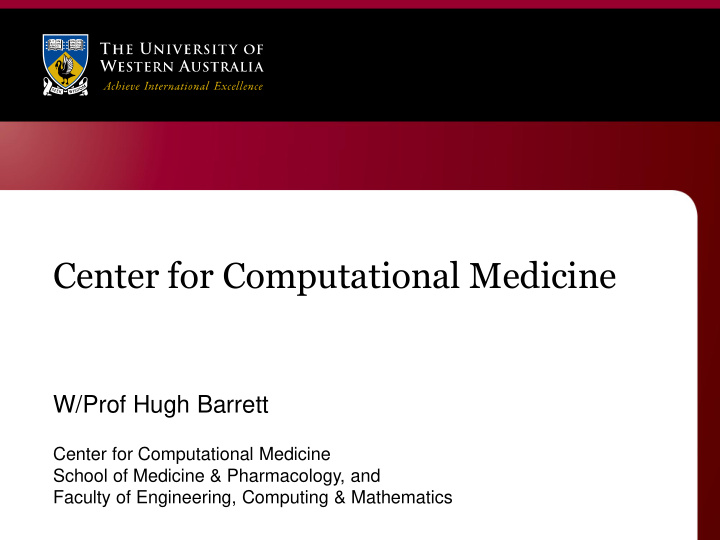



Center for Computational Medicine W/Prof Hugh Barrett Center for Computational Medicine School of Medicine & Pharmacology, and Faculty of Engineering, Computing & Mathematics
How to tackle the challenge of complex biological systems “Perhaps a proper understanding of the complex regulatory networks making up cellular systems like the cell cycle will require a shift from common sense thinking. We might need to move into a strange more abstract world, more readily analysable in terms of mathematics” Sir Paul Nurse The Nobel Prize in Physiology or Medicine 2001
Integrative methods, large amounts of relevant data
Rationale for a Center on Computational Medicine • Systems Biology & Computational Biology push in the US and Europe – EU Virtual Physiological Human Project – NIH NIGMS Systems Biology • $100m Victorian Life Science Computational Initiative
NIH NIGMS
Rationale for a Center on Computational Medicine • Opportunity to Value-Add to ongoing research – Application of engineering and mathematics to medicine (and biology) • Provide insight into complex biology using a variety of computational tools • Development of new testable hypotheses – Integral in new grant applications – Simulation of systems
CCM - Purpose of the Centre • Bring greater engagement of computational methods to medical and biological research • Focus on quantitative, systems analysis of cells, tissues and organs in normal and disease states Normal Modeling bone deposition and resorption Bone loss
CCM - Purpose of the Centre • Motivation is to translate new findings and insights into improved patient care through the integration of data and knowledge – Knowledge of a system and how it responds to intervention Model of lipoprotein metabolism in obesity
FDA approved Metabolic Simulator
CCM - Purpose of the Centre • Operate across FECM and FMDHS, but would also include collaborators from other faculties • Collaborate outside of UWA at national and international level – NHMRC support • Strong collaborative track record – Publications and grants High density lipoprotein model
Currently held competitive funding 2009-2011 ARC-DP Engineering cartilage homeostasis in health and disease $230,000 ARC-DP Multiscale modeling of transport through deformable porous materials $450,000 NHMRC Simulations of colon cancer $528,000 NHMRC Regulating fluid mechanics to improve outcomes for glaucoma surgery $269,000 PCCA Prostate metatasis to bone $280,000 NHMRC Reducing CVD risk in the metabolic syndrome and Type 2 diabetes: Novel approaches to studies of lipoprotein metabolism $527,725 NHMRC Therapeutic regulation of hepatic steatosis and lipid transport in the metabolic syndrome $501,775 2010-2012 NHMRC Hypoxia is the common pathway to renal failure $478,000 2011-2014 ARC Linkage Bioengineered scaffolds for Achilles tendopathy treatment $840,000 2011-2015 NHMRC Senior Research Fellow 2012-2014 NHMRC Niacin lowers Lp(a) concentrations in type 2 diabetes $394,920 2012-2014 NHMRC Regulation of triglyceride-rich lipoprotein metabolism in familial hypercholesterolaemia $594,770 2012-2014 NHMRC Investigating the roles of the wnt and notch signalling systems in colon cancer crypt biology $548,675
CCM Main Activities New algorithms Computational Software tools Methods CCM PG Outreach Core Training Programs & Postdocs Assoc Symposia PhD students Modeling workshops PG courses Collaboration Value-add Integral to research
Members of CCM W/Prof David Smith Dr Stefan Scheiner W/Prof Hugh Barrett Dr Edward Green A/Prof Bruce Gardiner Dr Richard van der Wath A/Prof Peter Pivonka Ms Sarah Thompson Dr Pascal Bünzli Dr John Davidson
Priorities for the future • Seek additional strategic collaborative opportunities – Value-add to existing research projects – Partner with collaborators on ARC/NHMRC project/program and center grants • Formalize the Center for Computational Medicine within UWA (UWA OPP Bioengineering & Bio-imaging) – Seek management support – Seek additional space and PhD students • Co-localization within medical institutes – Develop strategy for education and training – Expand number of associated members to increase expertise and capability
Priorities for the future • Establish national and international profile – Maintain and develop new national and international collaborations – Be productive – Attract PG students and staff – Run symposia (Outreach program) • 2011 Cartilage and Bone Research • 2012 Computational Systems Biology • Modeling workshops • Prepare bid for a National Center
Center for Computational Medicine • Contacts – David Smith 6488 5531 David.Smith@uwa.edu.au – Hugh Barrett 6488 3459 Hugh.Barrett@uwa.edu.au • Location – Computer Science and Software Engineering Building, M002
Recommend
More recommend